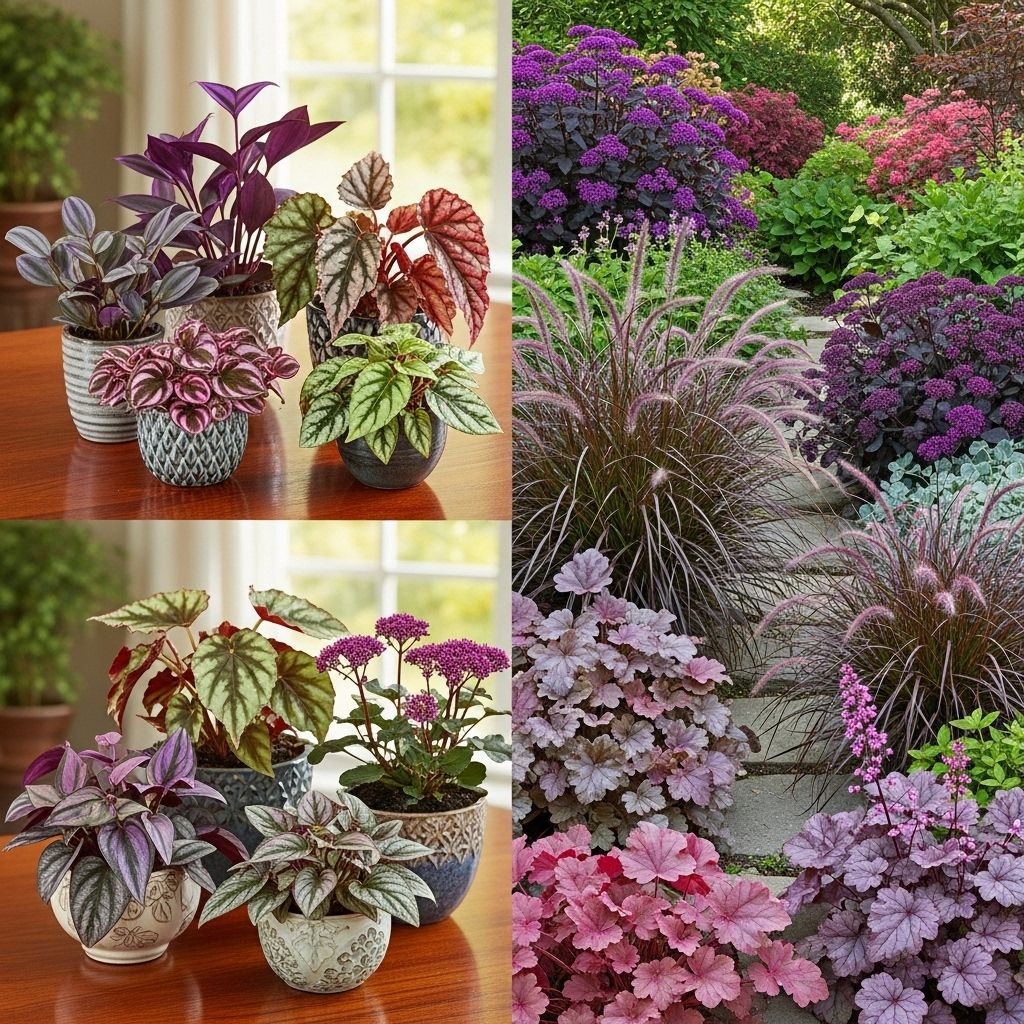Plants With Purple Leaves: 46 Striking Indoor & Outdoor Picks
Transform your indoor and outdoor spaces with an array of vibrant plants boasting spectacular purple foliage.

Image: HearthJunction Design Team
46 Stunning Plants With Purple Leaves for Indoor & Outdoor Gardens
Looking to add a bold splash of color to your home or garden? Purple-leaf plants are a remarkable way to introduce a dramatic, regal flair. With hues ranging from deep burgundy to vibrant violet, these plants deliver striking foliage year-round. In this comprehensive guide, we’ll explore 46 of the best indoor and outdoor plants with purple leaves, including their unique characteristics, growing needs, and tips for integrating them into your landscape or interior decor.
Why Choose Plants With Purple Leaves?
Purple-leafed plants offer more than just visual appeal. Their rich colors can:
- Create focal points in gardens or containers
- Complement green foliage with vivid contrast
- Thrive in a variety of outdoor and indoor environments
- Attract pollinators with their unique hues
Whether for dramatic curb appeal, a whimsical border, or a standout houseplant, purple-leafed varieties infuse artistry and energy into any space.
Types of Purple-Leaf Plants
You’ll find plants with purple foliage across multiple categories, including:
- Perennials
- Annuals
- Shrubs
- Ornamental grasses
- Trees
- Vines and ground covers
- Houseplants
Below, we’ve organized these purple wonders into categories to simplify your selection process.
Outdoor Plants With Purple Leaves
Outdoor spaces benefit from the depth and intrigue of purple foliage. Here are standout choices for your garden landscape:
Perennials
- Black Magic Elephant Ear (Colocasia esculenta)
Features enormous, heart-shaped leaves with shades from dark green with purple veins to nearly black burgundy. Thrives in rich, moist, well-drained soils and is prized for its striking vegetation rather than its insignificant flowers. - Heuchera (Coral Bells)
Known for their ruffled leaves in shades of deep purple, plum, and silver-tinged violet, making them a favorite for shady borders and container gardens. - Ajuga (Bugleweed)
Many ajuga cultivars, such as ‘Black Scallop,’ have leaves that range from green to intense purple-black, especially in bright sunlight. It’s a low-maintenance, spreading ground cover that adapts to various soils. Note: Some varieties may be invasive in certain regions, so always check local guidelines before planting. - Japanese Painted Fern (Athyrium niponicum)
Offers elegant, silvery-green fronds streaked with purple, adding texture and color to shade gardens. - Purple Emperor Sedum
A drought-tolerant perennial succulent featuring deep purplish-red leaves and clusters of bright pink flowers in late summer.
Shrubs
- Loropetalum
These evergreen shrubs display oval-shaped, rich purple leaves year-round and often bloom with fuchsia fringe-like flowers. - Smoke Bush (Cotinus coggygria)
The ‘Royal Purple’ variety sports dramatic, rounded purple leaves that darken to crimson in autumn. - Barberry (Berberis spp.)
Varieties like ‘Crimson Pygmy’ offer dense, spiny shrubs with deep burgundy to purple leaves, perfect for low borders or wildlife deterrence. - Purple Leaf Sand Cherry (Prunus × cistena)
A hardy shrub with reddish-purple foliage and fragrant pale pink spring blooms.
Ornamental Grasses & Ground Covers
- Fountain Grass (Pennisetum spp.)
Cultivars like ‘Fireworks’ showcase variegated burgundy and purple blades with soft plumes in late summer. - Tradescantia (Tradescantia pallida, Purple Heart)
Features vivid purple stems and leaves, famed as a cascading border or ground cover in warm climates.
Trees With Purple Foliage
- Forest Pansy Redbud (Cercis canadensis ‘Forest Pansy’)
This small ornamental tree boasts heart-shaped leaves that emerge purple and mature to maroon, with pink spring blossoms. - Purpleleaf Plum (Prunus cerasifera)
Known for its dark, glossy purple leaves and showy spring flowers, this tree brightens any cityscape or lawn.
Annuals & Vines With Purple Leaves
- Purple Emperor Trailing Nasturtium
With deeply veined petals in purple, lavender, and dusty rose, these trailing nasturtiums are ideal for ground cover or hanging baskets. Both flowers and leaves are edible, adding a peppery accent to dishes. - Purple Sweet Potato Vine (Ipomoea batatas)
Grown mainly for its vigorously spreading, heart-shaped purple leaves, this annual is popular in containers or as a bright ground cover. - Purple Fountain Amaranth (Amaranthus spp.)
Offers deep maroon foliage and feathery flower plumes, perfect for adding bold contrast to summer beds. - Setcreasea (Tradescantia pallida ‘Purple Heart’)
An easy annual in cool climates, this trailing vine presents intensely purple stems and leaves, making it a striking centerpiece in containers.
Houseplants With Purple Leaves
Indoor gardeners can also enjoy purple foliage! Here are some of the most attractive and easy-to-grow options:
- Purple Passion Plant (Gynura aurantiaca)
This exotic houseplant sports fuzzy, soft purple hairs on green leaves. It thrives in bright, indirect light and well-drained soil. The plant is easy to propagate and stands out in any indoor collection, though its yellow-orange flowers are best pinched off due to their strong odor and indication of the plant’s lifecycle end. - Rex Begonia
Boasts spectacular, ruffled purple, silver, and green foliage. Prefers high humidity and indirect light, making it ideal for bathrooms or terrariums. - Calathea (Calathea roseopicta ‘Dottie’)
Features striking deep purple-black leaves with fuchsia pink markings and patterned undersides. - Tradescantia Zebrina (Wandering Dude)
Offers variegated leaves with rich purple undersides and metallic stripes, perfect for hanging baskets. - Oxalis Triangularis (Purple Shamrock)
Displays shamrock-shaped purple leaves and delicate pink or white flowers, opening and closing daily with sunlight. - Persian Shield (Strobilanthes dyerianus)
Boasts iridescent violet leaves with metallic veins, ideal for brightening any windowsill or conservatory.
Growing & Care Tips for Purple-Leaf Plants
The best care tips depend on whether your plant is destined for the garden or indoors, but most purple-leafed varieties thrive with the following guidelines:
- Light: Most purple-leafed plants need bright, indirect light to maintain vivid color. Too much shade can turn leaves green, while direct sun can scorch foliage.
- Soil: Well-drained, loamy soil is ideal for most varieties. Amend heavy or sandy soils with organic matter for better drainage and moisture retention.
- Water: While needs vary, avoid letting soil become waterlogged. Water when the top inch of soil is dry.
- Fertilizer: Use a balanced, slow-release fertilizer during the active growing season for lush, healthy foliage.
- Maintenance: Pinch or prune to encourage bushy growth and remove faded leaves or flowers to promote vigor.
Landscape & Design Ideas
Maximize the visual impact of purple-leafed plants in your landscape with these expert ideas:
- Plant in clusters or mass plantings for a bold effect.
- Pair with silver, gold, or lime-green foliage for dramatic contrast.
- Use as backdrops for lighter-colored flowers or variegated leaves.
- Mix textures — combine fine, feathery leaves with bold, broad ones.
- Try purple-leafed specimens in containers for patios, porches, and balconies.
Summary Table: Top Purple-Leaf Plants by Type
| Category | Plant Example | Key Features |
|---|---|---|
| Perennial | Black Magic Elephant Ear | Huge, heart-shaped purple leaves |
| Shrub | Loropetalum | Evergreen, oval purple leaves, fuchsia flowers |
| Tree | Purpleleaf Plum | Dark purple glossy leaves, spring blooms |
| Annual | Purple Emperor Nasturtium | Trailing, edible purple-tinged foliage |
| Houseplant | Purple Passion Plant | Fuzzy purple hairs on green leaves |
Frequently Asked Questions (FAQs)
Q: Are purple-leafed plants more challenging to grow than green-leafed ones?
A: Not usually. As long as they receive the right light and water, most purple-leafed plants are as easy to grow as their green counterparts. However, intense color generally requires more sunlight.
Q: Will purple-leafed plants retain color indoors?
A: Yes, but they need ample indirect sunlight. Too little light can cause purple hues to fade to green.
Q: Are there edible plants with purple leaves?
A: Certainly! Purple Emperor Nasturtium leaves and flowers are edible, as are purple-leafed sweet potato vines, which offer both ornamental and culinary value.
Q: Can purple-leafed plants survive in shade?
A: Some, like Heuchera and Ajuga, tolerate partial shade but display the best color in brighter light. Always match plant selection to your garden’s conditions.
Q: What causes the deep purple coloration in leaves?
A: Anthocyanins, natural pigments, are responsible for purple, red, and blue shades in plant foliage. These pigments protect leaves from excess sunlight and may deter herbivores.
Conclusion
From striking perennials to dazzling houseplants, purple-leafed plants offer an incredible range of textures, forms, and shades. With proper care and thoughtful placement, you’ll enjoy their captivating hues across seasons, indoors and out. Ready to transform your garden or living room with purple foliage? Choose one—or several—from the list above and start creating a vibrant, unforgettable display today!
References
Read full bio of medha deb












